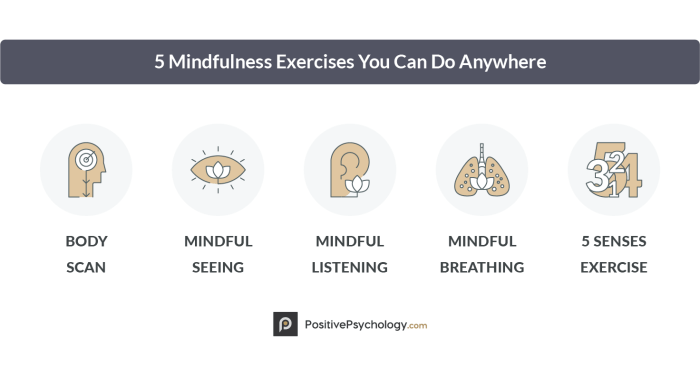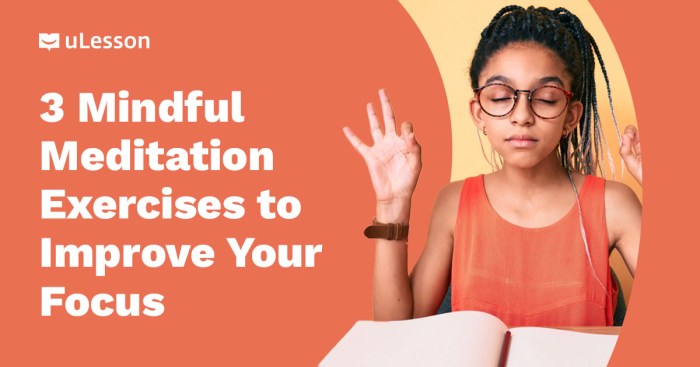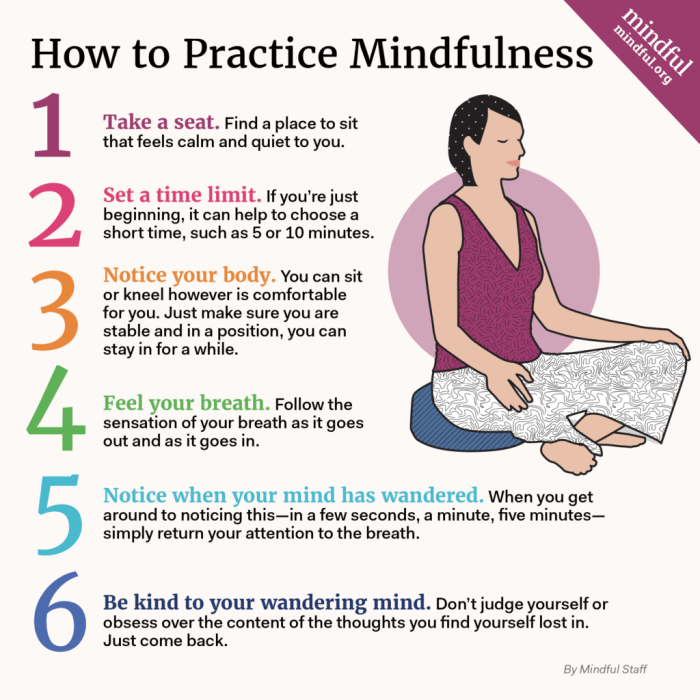Embark on a journey of self-discovery and emotional healing with 10 Mindful Meditation Practices for Emotional Growth. Dive into a world where mindfulness meets meditation, exploring techniques that nurture your soul and elevate your well-being.
From deep breathing to visualization, each practice offers a unique path to inner peace and emotional resilience. Let’s explore these transformative practices together.
Introduction to Mindful Meditation

Mindful meditation is a practice that involves focusing on the present moment without judgment. It helps individuals cultivate self-awareness, reduce stress, and enhance emotional well-being. Unlike traditional meditation, which may involve clearing the mind completely, mindful meditation encourages acknowledging and accepting thoughts and feelings as they arise.
Benefits of Mindful Meditation for Emotional Growth
- Enhances Emotional Regulation: Mindful meditation teaches individuals to observe their emotions without reacting impulsively, leading to better emotional regulation.
- Reduces Anxiety and Depression: By practicing mindfulness, individuals can shift their focus away from negative thoughts, reducing symptoms of anxiety and depression.
- Increases Self-Compassion: Mindful meditation fosters self-compassion by encouraging individuals to treat themselves with kindness and understanding.
- Improves Relationship Satisfaction: Being present and attentive through mindfulness can improve communication and empathy in relationships, fostering emotional growth.
Breathing Techniques in Mindful Meditation
Breathing techniques play a crucial role in mindful meditation as they help in calming the mind, reducing stress, and promoting emotional well-being. Deep breathing, in particular, is highly beneficial for emotional regulation and overall mental health.
Diaphragmatic Breathing
Diaphragmatic breathing, also known as belly breathing, involves breathing deeply into the diaphragm rather than just the chest. This technique helps in activating the body’s relaxation response, reducing stress and anxiety levels. To practice diaphragmatic breathing:
- Sit or lie down in a comfortable position.
- Place one hand on your chest and the other on your abdomen.
- Inhale deeply through your nose, feeling your abdomen rise as you breathe in.
- Exhale slowly through your mouth, feeling your abdomen fall.
- Repeat this process for a few minutes, focusing on the sensation of your breath.
Counted Breathing
Counted breathing is a simple yet effective technique to enhance mindfulness and concentration. By counting your breaths, you can anchor your awareness in the present moment and calm your mind. To practice counted breathing:
- Sit or stand comfortably with your eyes closed.
- Inhale slowly and deeply through your nose while counting to four.
- Hold your breath for a count of four.
- Exhale slowly through your mouth, counting to four.
- Repeat this cycle for several minutes, focusing on the rhythm of your breath.
Box Breathing
Box breathing, also known as square breathing, is a technique used to regulate breathing patterns and induce a sense of calmness. This method involves inhaling, holding, exhaling, and holding the breath in equal counts. To practice box breathing:
- Sit in a comfortable position and close your eyes.
- Inhale deeply through your nose for a count of four.
- Hold your breath for a count of four.
- Exhale slowly through your mouth for a count of four.
- Hold your breath again for a count of four.
- Repeat this sequence several times, maintaining a steady rhythm.
Body Scan Meditation

Body scan meditation is a mindfulness practice that involves focusing on different parts of the body, starting from the toes and moving up to the head. This practice helps individuals develop awareness of physical sensations, release tension, and cultivate a deeper connection between the mind and body.
Process of Body Scan Meditation
- Find a comfortable position either sitting or lying down.
- Close your eyes and bring your attention to your breath, taking a few deep breaths to relax.
- Start by focusing on your toes, noticing any sensations or tension in that area.
- Gradually move your attention up through each part of the body, scanning for any tightness, discomfort, or areas of relaxation.
- As you scan each body part, breathe into any tension you may feel, allowing it to release and soften.
- Continue this process until you reach the top of your head, being fully present and aware of each sensation you experience.
Effects on Mindfulness
Body scan meditation helps individuals develop a heightened sense of body awareness, promoting relaxation, stress reduction, and emotional regulation. By regularly practicing body scan meditation, individuals can improve their ability to stay present in the moment, cultivate self-compassion, and enhance overall emotional well-being.
Personal Experiences
“After incorporating body scan meditation into my daily routine, I noticed a significant decrease in my stress levels and an improved sense of connection with my body. I feel more grounded and centered, able to navigate my emotions with greater ease.”
“Body scan meditation has been a game-changer for me. It has helped me become more in tune with my body and emotions, allowing me to respond to challenging situations with mindfulness and compassion.”
Loving-Kindness Meditation
Loving-Kindness Meditation, also known as Metta Meditation, is a practice that involves cultivating feelings of love, compassion, and goodwill towards oneself and others. This practice aims to promote emotional well-being, reduce negative emotions, and increase positive feelings.
Significance of Loving-Kindness Meditation
Loving-Kindness Meditation plays a crucial role in cultivating positive emotions by shifting the focus from self-criticism and judgment to self-compassion and empathy. This practice helps individuals develop a sense of connection with others and fosters feelings of kindness and understanding.
- Enhances Self-Compassion: By practicing loving-kindness meditation, individuals learn to treat themselves with kindness and compassion, leading to improved self-esteem and self-acceptance.
- Fosters Empathy: This meditation practice promotes empathy towards oneself and others, fostering a sense of interconnectedness and understanding of shared human experiences.
Loving-Kindness Meditation Phrases
When engaging in loving-kindness meditation, individuals often recite phrases or mantras to cultivate feelings of love and compassion. Some examples of loving-kindness meditation phrases include:
May I be happy.
May I be healthy.
May I live with ease.
May all beings be safe.
May all beings be happy.
May all beings be at peace.
Mindful Walking Meditation

Mindful walking meditation is a practice that involves bringing awareness to each step you take, focusing on the sensations in your body and the movement of your feet. This form of meditation can help you connect with the present moment, reduce stress, and improve emotional regulation.
Tips for Incorporating Mindful Walking into Daily Routines
- Choose a quiet and peaceful place to walk where you can be fully present.
- Start by setting an intention for your walk, such as focusing on gratitude or cultivating compassion.
- Pay attention to each step you take, feeling the ground beneath your feet and the movement in your body.
- Engage all your senses, noticing the sights, sounds, and smells around you as you walk.
- If your mind starts to wander, gently bring your attention back to the present moment and your walking experience.
Benefits of Combining Movement with Mindfulness for Emotional Regulation
- Enhances self-awareness and emotional intelligence by being in tune with your body and emotions.
- Reduces stress and anxiety by focusing on the present moment and letting go of worries.
- Improves mood and overall well-being by promoting relaxation and a sense of calm.
- Increases physical activity and promotes a healthy lifestyle by incorporating mindfulness into daily routines.
Visualization Meditation
Visualization meditation is a powerful technique that involves creating peaceful mental imagery to promote emotional healing and growth. By vividly imagining positive scenarios or outcomes, individuals can cultivate feelings of calmness, joy, and inner peace. This practice can help reduce stress, anxiety, and negative emotions, leading to improved overall well-being.
Concept of Visualization Meditation
- Visualization meditation involves focusing on a specific mental image or scenario to evoke positive emotions and sensations.
- By engaging the mind in a detailed visualization, individuals can create a sense of presence and connection to the imagined experience.
- This practice can help rewire the brain to associate positive feelings with certain situations, leading to a more optimistic outlook on life.
Creating Peaceful Mental Imagery
- Find a quiet and comfortable space where you can relax without distractions.
- Close your eyes and take a few deep breaths to center yourself and clear your mind.
- Visualize a peaceful and serene setting, such as a tranquil beach, a lush forest, or a peaceful garden.
- Engage your senses by imagining the sights, sounds, smells, and textures of this calming environment.
- Allow yourself to fully immerse in this mental imagery, focusing on the feelings of relaxation and inner peace it brings.
Benefits of Visualization Meditation
- Research has shown that visualization meditation can reduce stress levels and promote emotional well-being.
- A study published in the Journal of Clinical Psychology found that visualization techniques were effective in decreasing symptoms of anxiety and depression.
- By regularly practicing visualization meditation, individuals can enhance their ability to cope with challenging emotions and cultivate a more positive mindset.
Gratitude Meditation: 10 Mindful Meditation Practices For Emotional Growth
Gratitude meditation is a practice that involves focusing on and expressing gratitude for the positive aspects of your life. This mindfulness technique can have a profound impact on emotional well-being by shifting your focus from negativity to appreciation.
Impact on Emotional Well-being
-
Gratitude meditation can enhance positive emotions such as joy, contentment, and happiness.
-
By acknowledging and appreciating the good things in your life, you can reduce stress and anxiety levels.
-
Expressing gratitude regularly can improve overall mental health and increase feelings of fulfillment and satisfaction.
Incorporating Gratitude Meditation
- Start your day by reflecting on three things you are grateful for.
- Keep a gratitude journal to write down what you appreciate each day.
- Practice mindfulness during daily activities by focusing on the positive aspects.
Mindful Eating Meditation
Mindful eating meditation involves paying full attention to the experience of eating, focusing on the taste, texture, and sensations of each bite. This practice helps cultivate a deeper connection with food and promotes a greater sense of emotional awareness.
Tips for Practicing Mindful Eating
- Avoid distractions such as watching TV or scrolling through your phone while eating.
- Take time to appreciate the colors, smells, and flavors of your food.
- Chew slowly and savor each bite, noticing the changes in taste and texture.
- Listen to your body’s hunger and fullness cues to guide your eating.
- Express gratitude for the nourishment that the food provides.
Link Between Mindful Eating and Emotional Growth
Mindful eating can help improve emotional health by fostering a healthier relationship with food and promoting a more balanced approach to eating. By being present in the moment while eating, individuals can develop a better understanding of their emotional triggers and responses related to food. This practice can lead to a more mindful and intuitive approach to eating, ultimately supporting overall emotional growth and well-being.
Letting Go Meditation
Letting go meditation is a powerful practice that allows individuals to release negative emotions and thoughts that may be holding them back. By learning to let go of past grievances or worries through meditation, one can cultivate a sense of inner peace and emotional freedom.
Techniques for Letting Go
- Focus on the present moment: By redirecting your attention to the present moment, you can let go of rumination on past events or anxiety about the future.
- Practice forgiveness: Use meditation as a tool to forgive yourself and others, letting go of resentment and anger.
- Breathwork: Incorporate deep breathing exercises into your meditation practice to release tension and promote relaxation.
Benefits of Letting Go Meditation
- Emotional resilience: Letting go of negative emotions can build emotional resilience, helping you bounce back from setbacks more easily.
- Increased self-awareness: Through letting go meditation, you can gain insight into your thought patterns and emotional reactions, leading to greater self-awareness.
- Improved relationships: By releasing past grievances and worries, you can approach relationships with a fresh perspective and greater empathy.
Setting Intentions in Meditation

Setting intentions before a meditation practice is crucial for emotional growth as it helps focus the mind, create a sense of purpose, and guide our energy towards positive outcomes. By setting intentions, we can cultivate a deeper connection with ourselves, enhance self-awareness, and promote emotional balance.
Importance of Setting Intentions, 10 Mindful Meditation Practices for Emotional Growth
Setting intentions in meditation allows us to clarify our goals, desires, and values, helping us align our thoughts, emotions, and actions towards a specific direction. It provides a sense of purpose and meaning to our practice, enabling us to stay focused, motivated, and present in the moment. By setting intentions, we can create a positive mindset, cultivate gratitude, and enhance self-compassion, leading to emotional growth and personal transformation.
- Focus on cultivating self-love and acceptance, fostering a sense of compassion towards yourself and others.
- Set intentions to release negative emotions, thoughts, and beliefs, creating space for healing and growth.
- Practice gratitude by setting intentions to appreciate the present moment, acknowledge blessings, and express thankfulness.
Benefits of Setting Intentions
Setting intentions in meditation can help us develop a mindful and emotionally balanced mindset by directing our attention, energy, and awareness towards positive outcomes. It allows us to let go of distractions, worries, and fears, promoting inner peace, clarity, and emotional resilience. By focusing on intentions, we can create a sense of empowerment, purpose, and alignment with our values, leading to a more fulfilling and harmonious life.
- Enhance self-awareness and emotional intelligence by setting intentions to observe and understand your thoughts, feelings, and behaviors.
- Cultivate a sense of gratitude and abundance by setting intentions to focus on blessings, opportunities, and growth in every aspect of your life.
- Improve mental clarity and focus by setting intentions to stay present, mindful, and centered in the present moment, letting go of distractions and worries.
Final Review

As we conclude our exploration of 10 Mindful Meditation Practices for Emotional Growth, remember that true emotional growth begins from within. By incorporating these practices into your daily routine, you pave the way for a more mindful and balanced life. Embrace the journey ahead with an open heart and a peaceful mind.